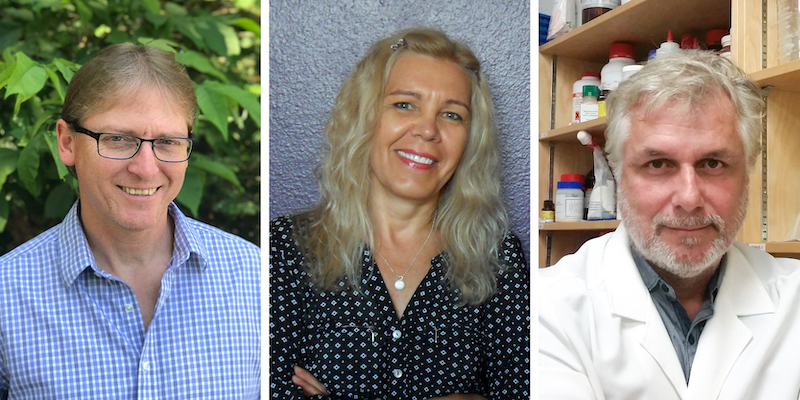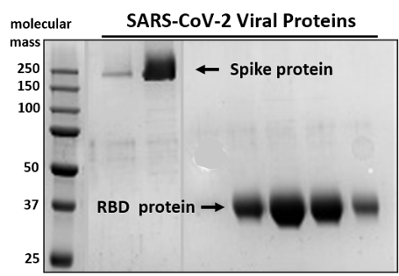COVID-19 researchers successfully create antigen production pipeline
Author: UNB Research
Posted on Mar 26, 2021
Category: Research , Partnerships , COVID-19

Around the world, researchers across all fields and disciplines continue to work on addressing the challenges, issues and implications of the 2019 novel coronavirus pandemic. Here at UNB, our own research community is part of that global movement.
Last year, we introduced you to 13 new, funded COVID-19 research projects and their teams; now, with a full year of pandemic life behind us, we’re checking in to see what they’re working on and what they’ve accomplished. Want catch up with the other teams? Keep an eye on this page for updates!
In today’s story, we peek into the lab of three UNB biology researchers, Dr. Michael Duffy, Dr. Aurora Nedelcu, and Dr. Shawn MacLellan, who last year were hoping to combine their expertise to help other researchers and testing labs. They shared some updates and insights about their work to date, and the science behind the interest in spike proteins.
Readers are likely familiar with the term “spike protein” from stories about the mRNA vaccines, or about the infection process of the coronavirus. In fact, much of the research into the coronavirus (SARS-CoV-2) causing the COVID-19 pandemic centers on that viral surface protein.
The spike protein is involved in attaching to human cells, and changes in its genetic makeup are responsible for new variants that potentially increase the virus’ infectivity. Because of this unique spike protein and the important role it plays in the virus’ spread, it is extensively used in the development of testing, therapeutic strategies and vaccines.
The goal of their project was to develop a viral protein expression and purification pipeline and then provide these (harmless) SARS-CoV-2 proteins for research and development purposes.
“We were successful in developing this pipeline, and ultimately purified large quantities of the spike protein and a fragment of the spike protein containing its receptor-binding domain,” said Dr. MacLellan. (The ‘receptor-binding domain’ is the part of the Spike protein that connects to your cells, initiating an infection.)

“The expression of the spike protein is unusually challenging because we need to introduce the viral gene into human cells grown under special and rigorous conditions to produce the protein,” added Dr. Nedelcu. “Subsequently, we used a technique called liquid chromatography to purify the target proteins from all other cellular constituents.”
Through this project, the research team have developed collaborations with other groups in Atlantic Canada and in other provinces that need these purified viral proteins for research and for the development of diagnostic tests that can help monitor infection rates.
“With the ongoing success of this pipeline, we have also been able to develop additional research projects at UNB,” said Dr. Duffy. “These include using the SARS-CoV-2 spike protein to learn more about the immune systems of aquatic species, and to build upon our existing pipeline to develop alternative strategies for purifying viral proteins. We have also been consulted by a major biotechnology company and provided information on making improvements to commercially available protein expression and purification reagents.
The investment in this project made by the New Brunswick Innovation Foundation, the New Brunswick Health Research Foundation, and the Atlantic Canada Opportunities Agency enabled this group of UNB biology researchers to combine their individual expertise into a successful solution; now, they hope to make further contributions to the investigation of the 2019 novel coronavirus.
“Although our efforts have focused on the cause of the current pandemic,” said Dr. MacLellan, “the pipeline we have developed can be used to provide research reagents for the study of other viruses and bacteria that can cause serious diseases in both humans and wildlife, here in New Brunswick and beyond.”
This research was funded by the New Brunswick Innovation Foundation, the New Brunswick Health Research Foundation, and the Atlantic Canada Opportunities Agency as part of a special COVID-19 funding program.
Media: If you are interested in this story, and would like more information, please contact Jeremy Elder-Jubelin, Marketing and Communications Officer in the Office of Research Services.
1 How does polyacrylamide gel electrophoresis work? Dr. MacLellan explains:
"We pass proteins solutions through a flat polymer gel that separates proteins according to size or mass. The bands along the left hand side are a series of different proteins that differ in size and the numbers indicate their actual size (the smaller the protein, the farther down the gel the protein migrates). We use this to provide a ruler of sorts. For example, the Spike protein should be about 250 units in size, and sure enough it runs parallel to the 250 ruler band. The RBD protein is much smaller and should be about 35 units in size and indeed runs close to the 37 ruler band. This technique shows us that we are working with the right proteins and also shows us that the proteins have been purified away from all other cellular proteins (if there were still other proteins present, we would see multiple black bands in each lane instead of just one)."
Looking for more detail on the process? Try this page from Rice University!
More information:
Dr. Shawn MacLellan | Dr. Michael Duffy | Dr. Aurora Nedelcu | Department of Biology, Fredericton
Research at UNB | Graduate Studies at UNB | Postdoctoral fellowships
Related Pages: COVID-19 research stories | COVID-19 research - where are they now?